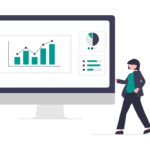From querying our way through the Data in the ’90s to building precise data visualization models today, we have come a long way in the journey of Data Analytics.
Switching from spreadsheets to dashboards has been a significant change in the third generation of Business Intelligence. The data-centric world is rapidly progressing toward the era of Self-Service Analytics.
What does Self-Service Analytics mean?
Well, let us dive deep into the topic without any further ado.
Self-Service Analytics entrusts its users with the capability to be their own Data Analysts.
A Self-Service Analytics suite equips you with all the tools that you will need to explore your datasets and discover meaningful insights. This facility enables any person to analyze data, create their reports, and ultimately make the organization more data-oriented.
Too many technical terms?
Here’s what Self-Service Analytics means in simpler terms:
Assume a scenario where you’re working in an organization with the Sales and Marketing Department. You need to organize a campaign to launch a new product.
What would a team without the facility of Self-Service Analytics do in such a case?
You’d probably allocate a budget for the campaign, head over to the Business Intelligence or Data Analyst team, and request them to build you a dashboard that presents the Key Performance Indicators (KPIs) of previous sales that will help segment and target the customers.
Then the Analytics team will coordinate with you to understand the parameters that you require and decode the technical specifications.
They will pass on these specifications to the Data Engineering team, who will source the necessary data and design its storage architecture.
Simultaneously a developer will work on developing the frontend of the dashboard.
There you go. Your dashboard is now ready.
Phew! That involved too many roles. Both resources and time consumed in this case are more.
Now let us review the same scenario, only this time the organization is driven by Self-Service Analytics.
In this case, you are the Data Expert yourself. You use tools to design a dashboard, develop it and use SQL to load it with data or maybe just drag and drop the data. You don’t have to depend on anyone to get this job done. You save time, plus you can use the dashboard right away.
Isn’t this great?
What makes Self-Service Analytics so impactful?
Wouldn’t you prefer a dashboard with neat data representations over an excel spreadsheet of massive datasets?
Visualization is the key element of any Self-Service Analytics suite.
Self-Service Analytics lets you visualize your data on the go. You can pull up the previous records, monitor the data in real-time, and keep track of the KPIs.
It also helps you to align your work goals with that of the organization and brings in more value from every task.
A Self-Service Analytics suite is not restricted to a visualization dashboard. It helps you effortlessly query the data and derive all the necessary information.
The best part? You do not even need to be a programming expert to execute these tasks!
What are the other benefits of Self-Service Analytics?
a) Self-reliance
You do not need to rely on the IT department anymore. Moreover, the IT department can focus on tasks that are of higher value. A win-win situation.
b) Proper utilization of time and resources
You do not have to go to the IT professionals for these analytics tasks anymore. You can explore the data, find solutions on your own and make a data-informed decision.
c) Data Literacy
Data literacy lays the pathway for a data-driven organization. When an organization advocates Self-Service analytics, employees learn to understand, analyze, and manipulate data. Decisions backed by data are more efficient and give you an edge over the market competition.
Organizations are now aware of the significance their data holds and how fast decisions can be made from data but most of them are still dependent on IT to implement End to End BI stack including the creation of a Dashboard. With years of experience working in data and product management and product development, my team and I appreciate and understand the need for a simple to use Self-Service Analytics tool that can empower everyone to be self-reliant in creating Reports and Dashboards on their own and make a quick data-informed decision.
Meet Grafieks, a Self-Service Analytics platform built for everyone. With Grafieks anybody can connect to their data, and build reports and dashboards. Grafieks is on a journey to enable everyone to get an answer from their data on their own, with very minimal support from IT.
